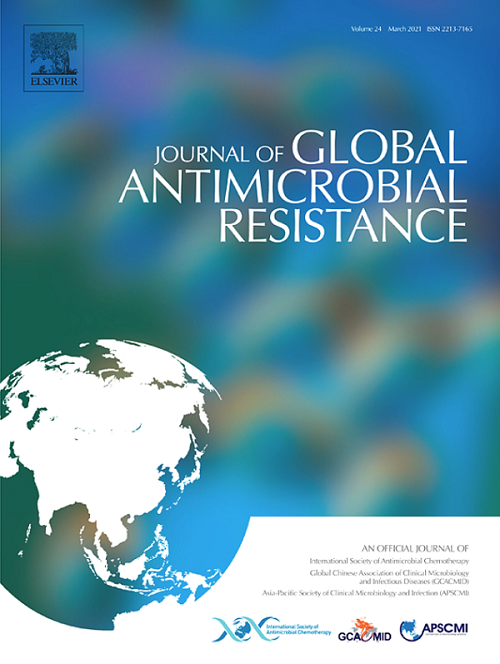Imipenem/cilastatin encapsulation in UIO-66-NH2 carrier as a new strategy for combating imipenem-resistant Pseudomonas aeruginosa isolates
IF 3.7
3区 医学
Q2 INFECTIOUS DISEASES
引用次数: 0
Abstract
Background
This study aims to investigate the effectiveness of UIO-66-NH2, a metal-organic framework, as a carrier for imipenem/cilastatin (Imp/Cil) in overcoming resistance in clinical isolates of imipenem-resistant Pseudomonas aeruginosa.
Methods
The UIO-66-NH2-Imp/Cil formulations were synthesized and characterized using dynamic light scattering, scanning electron microscopy, and transmission electron microscopy. Drug entrapment efficiency of UIO-66-NH2-Imp/Cil, and Imp/Cil release rates were determined. The stability of formulations was assessed at room temperature and refrigeration for two months. The antibacterial, anti-biofilm, and anti-virulence activities of formulations were investigated against imipenem-resistant P. aeruginosa isolates.
Results
The UIO-66-NH2-Imp/Cil formulation showed an average particle size of 212.3 ± 7.3 nm, a polydispersity index of 0.142 ± 0.010, and an entrapment efficiency (EE%) of 74.19% ± 1.12%. Drug release from the formulation followed a Korsmeyer-Peppas kinetic model, with 52% of the drug released over 72 h. Antibacterial testing indicated a significant decrease in minimum inhibitory concentration (MIC) and minimum bactericidal concentration (MBC) for the UIO-66-NH2-Imp/Cil formulation compared to free Imp/Cil, demonstrating enhanced antibacterial activity. Furthermore, the anti-biofilm and anti-virulence activity of UIO-66-NH2-Imp/Cil was confirmed by the reduction of bacterial haemolysis activity, minimal pyocyanin, EPS (extracellular polymeric substance) production, and lower metabolic activity of pathogens. Also, UIO-66-NH2-Imp/Cil causes significant reduction in the expression of lasA, lasB and, rhlA genes, which resulted in the inhibition of quorum-sensing system activity.
Conclusions
These findings indicate that UIO-66-NH2-Imp/Cil nanocarriers offer a promising new approach against multidrug-resistant Gram-negative pathogens, providing insights into potential mechanisms of antimicrobial action.

UIO-66-NH2载体亚胺培南/西司他汀包封作为抗亚胺培南耐药铜绿假单胞菌的新策略
背景:本研究旨在探讨金属有机骨架(MOF) UIO-66-NH2作为亚胺培南/西司他汀(Imp/Cil)载体对耐亚胺培南铜绿假单胞菌临床分离株的耐药效果。方法:合成UIO-66-NH2-Imp/Cil配方,并采用动态光散射(DLS)、扫描电镜(SEM)和透射电镜(TEM)对其进行表征。测定UIO-66-NH2-Imp/Cil的药物包封效率和Imp/Cil释放率。通过室温和冷藏两个月来评价制剂的稳定性。研究了制剂对耐亚胺培南铜绿假单胞菌的抑菌活性、抗生物膜活性和抗毒活性。结果:UIO-66-NH2-Imp/Cil配方的平均粒径为212.3±7.3 nm,多分散指数(PDI)为0.142±0.010,包封效率(EE%)为74.19±1.12%。药物释放遵循Korsmeyer-Peppas动力学模型,在72小时内释放52%的药物。抑菌试验表明,与游离Imp/Cil相比,UIO-66-NH2-Imp/Cil配方的最低抑菌浓度(MIC)和最低杀菌浓度(MBC)显著降低,抗菌活性增强。此外,UIO-66-NH2-Imp/Cil的抗生物膜和抗毒活性通过降低细菌溶血活性,减少pyocyanin, EPS(胞外聚合物质)的产生和降低病原体的代谢活性得到证实。此外,UIO-66-NH2-Imp/Cil导致lasA、lasB和rhlA基因的表达显著降低,从而抑制群体感应(QS)系统活性。结论:这些发现表明UIO-66-NH2-Imp/Cil纳米载体为抗多重耐药革兰氏阴性病原体提供了一种有希望的新途径,并为抗菌作用的潜在机制提供了新的见解。
本文章由计算机程序翻译,如有差异,请以英文原文为准。
求助全文
约1分钟内获得全文
求助全文
来源期刊

Journal of global antimicrobial resistance
INFECTIOUS DISEASES-PHARMACOLOGY & PHARMACY
CiteScore
8.70
自引率
2.20%
发文量
285
审稿时长
34 weeks
期刊介绍:
The Journal of Global Antimicrobial Resistance (JGAR) is a quarterly online journal run by an international Editorial Board that focuses on the global spread of antibiotic-resistant microbes.
JGAR is a dedicated journal for all professionals working in research, health care, the environment and animal infection control, aiming to track the resistance threat worldwide and provides a single voice devoted to antimicrobial resistance (AMR).
Featuring peer-reviewed and up to date research articles, reviews, short notes and hot topics JGAR covers the key topics related to antibacterial, antiviral, antifungal and antiparasitic resistance.
 求助内容:
求助内容: 应助结果提醒方式:
应助结果提醒方式:


